Electronic Music in Toronto and Canada in the Analogue Era
The following article is a transcript of a presentation to the Toronto chapter of the Audio Engineering Society (AES) on 27 January 2009 at Walter Hall, University of Toronto, re-edited for publication in eContact! 11.2. The author was asked to present an overview of electronic music, studios and techniques, etc. in the analogue days. This is a subject which is old hat to many of us, but is certainly of interest to remind people what composing using those time-consuming techniques consisted of, and just how difficult it was.
Early History
Thank you for inviting me to speak to you about a subject that was almost a passion of mine when I was younger, Electronic Music. I don’t think we can talk about Electronic Music today without taking a quick look at musical history. Composers have always been interested in new instruments and new ways to make music, some more than others. Going back a few hundred years, Handel and Bach, and the two Bach sons all produced pieces for mechanical instruments, organs and clocks. In 1601, Hans Leo Hassler started making pieces for musical clocks, and soon afterwards, we get more famous composers producing pieces for these mechanical instruments. From about 1700 to the early 1800s, there was a lot of activity involving mechanical instruments. Even Beethoven got involved. His Battle Symphony was first for a huge mechanical orchestra, invented by the same man who invented the metronome, Johann Nepomuk Maelzel. Beethoven’s Symphony was composed in 1813, and apparently was quite a potboiler.
In the 100 years that followed, there was not much use of mechanical instruments by composers, until 1917, when Stravinsky did a study for pianola. Then people started using the new technology, which was gramophone records and film soundtracks and so on, different ways of recording sounds. And the interest began again, but this time it was different.
Just to diverge for a moment, back in the 1970s an English colleague of mine, Hugh Davies, was collecting data for a publication which he intended to publish, called the History of Recorded Sound. It was a huge project, and I’m not sure he ever completed it, but he did publish a Catalogue of Electronic Music in 1968 and early 1969. In my conversations with him, he told me a little story, which was quoted from an electronic magazine article in the 1930s. It describes a visit to China, where a man went into an old temple. There was a door, and when you opened it, there was a spike at the bottom of the door which ran in a groove, and the groove was ridged in such a way that it made the Chinese sound of “Please close the door.” Then when you closed the door, the sounds played backwards made the Chinese “Thank you.” That little anecdote traces back to 370 BC. Hugh was not sure whether it was a spoof, but he felt the Electronic Magazine was quite reputable, and he could imagine the Chinese way of thinking. So you see, the History could indeed be very old.
Coming back to the early part of the 20th century, there are predecessors of electronic music which captured the imagination of musicians. The ondes Martenot, invented by Maurice Martenot in France, was patented in 1922. The Theremin, invented by the Russian Leon Theremin around 1920, was another of these instruments, as was the Trautonium, developed by Friedrich Trautwein of Berlin. The later Mixtur Trautonium was the exclusive instrument of Oscar Sala in Berlin, who tried to take it into the concert hall, but it was too cumbersome, apparently. And of course, the Hammond Electric Organ we know. The American Taddeus Cahill invented his telharmonium, or Dynamophone as he called it, and of course there were many others working in the field and trying to come up with new instruments.
Important composers of the 20th Century such as Paul Hindemith and Edgard Varese attempted to utilize these instruments, but their interest was short lived, possibly due to the limitations of the instruments and the difficulty of transporting them into the concert hall. But some of them are still in use today, the ondes Martenot and the electronic organ come to mind. Without the invention of electricity, these early instruments would not have existed. As these early inventions are well documented, I will not spend time on them.
Then came the Second World War. Out of this chaos came magnetic tape and the tape recorder, which without question revolutionized the field of music. The technology for the tape and tape recorder was well known in the 1930s, but then there were improvements that took place during the War, such as, I believe, replacement of the noisy paper tape to a plastic based tape, for one, improving the bias frequency and so on. In the field of music and the recording of it, this was a huge step forward.
Mid-20th Century: Three Schools
To make the subject simple, the use of magnetic tape in composition in the very early days can be classified into three schools of thought.
The first experiments started in Paris about 1948. At the French Radio, there was an engineer by the name of Pierre Schaeffer who had established quite a reputation for making sound montages for radio programs. He had developed an amazing technique using discs to transform his recorded sounds, and when tape came along, he had become so ingrained using disc manipulation, he was reluctant to change over. His work was primarily for use in radio programs, creating montages for radio dramas, background sounds, or possibly even an attempt to make radiophonic music, something that was made inside the radio with artificial means. His work became known as “musique concrète”.
The first broadcast of Schaeffer’s experiments occurred in 1948 and caused quite a flurry of criticism. One of the pieces used recorded sounds from the French railway, which he called “Etudes aux chemins de fer — a bruitage. In other words a noise montage. This idea of using complex sound material to make even more complex sounds, and call it music, was terribly controversial, and upset a number of composers. They called it uncontrollable, chaotic, etc.
But Schaeffer’s work stimulated a lot of interest in the idea of using technology as a dimension of music. Pierre Henri, a composer, later joined Schaeffer, and they collaborated on a number of pieces including an opera for concrete sounds and voice titled Orpheus. This was now 1950, and the studio then invited other composers in, including the famous Olivier Messiaen and his pupil, Pierre Boulez. The first public presentation of musique concrète was in the same year, and tapes and recordings were presented at Tanglewood in the Unites States as well.
Karlheinz Stockhausen was in Paris in 1951, attending the classes of Messiaen, and heard these early pieces by Schaeffer. He was immediately interested in trying to synthesize sound, but he wanted to get away from the treatment of recorded sound. So he began his first experiments with sine waves, not at the French Radio but at the Studio of the French Post, which had a generator. While in Paris, he met Karel Goeyvaerts, a Belgian composer, and they both were interested in the idea of synthesizing timbres, and exchanged a lot of letters on the subject. Stockhausen returned to Germany where he met with Dr. Meyer-Eppler, head of the Phonetic Department and Communications Science at the University of Bonn, and with Dr. Herbert Eimert, who was a music critic. Between the three gentlemen, the Cologne Radio Electronic Music Studio was founded. That was in 1953. This studio had a different æsthetic from the Paris group, however, presumably guided by Stockhausen but very much influenced by Meyer-Eppler. Music created there, at that time, was made from pure electronically generated sounds, and it was referred to as “elektronische Musik”. The compositional techniques which Stockhausen employed came from post-serial developments, which were coming to the foreground then, stimulated by the rediscovery of the music of Anton Webern. The Electronic Music Studio officially opened in 1953, and in 1954 the first concert of elektronische Musik was presented. Belgian composer Karel Goeyvaerts had been working in the Studio, and he recounted the reaction to the music. He told me that the music totalled only about 20 minutes, but the introductions by Herbert Eimert were very complicated and esoteric, and about three times longer than the compositions. The audience was more interested in the speech than the music. When Dr. Eimert left the stage, the audience was left with nothing but enormous loudspeakers on the stage which upset him immensely.
And indeed, that was one of the problems of presentation of electronic music in the early days.
Other names connected to the Cologne Radio Studio included Henri Pousseur, and a young German Gottfried Michael Koenig, to mention just a couple.
Back in the USA, the activities centred around Columbia University. Otto Luening, a composer born in Wisconsin in 1900, was teaching at Columbia, as was Vladimir Ussachevsky, a Russian who emigrated to the US in 1930, primarily to pursue a career in engineering. But the circumstances of the time prevented him from that career, and he resorted to his knowledge of music. What drew Luening and Ussachevsky together in part was due to the fact that they both had skills as improvisors, Ussachevsky having improvised as a young man in silent films. Also, Ussachevsky was a pupil of Luening’s after the war years, and Luening knew that his pupil was running around with Columbia University equipment recording concerts all over New York. As a matter of fact, Ussachevsky told me he was fanatic about recording, for reasons he couldn’t explain. First of all he used wire, but he claimed it was inadequate for recording music, and there was no way to splice it together if it broke. Then he used a Brush tape recorder, which apparently was a first in the States which had any kind of success. It had a kind of stick shifting borrowed from the automobile, but it had many imperfections and was a troublesome machine.
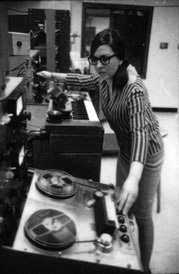
Then the Ampex tape recorder arrived on the scene, about 1951, and Luening and Ussachevsky began their first experiments which they called “Tape Music.” This Tape Music departed again from a perspective different than the pursuits in Paris and Cologne. Ussachevsky recorded instrumental sounds, the piano, flute and other musical instruments, and by using transpositions and feedback, cutting and splicing, created the early pieces. One of them, although quite simple, was impressive at the time — Sonic Contours, based on the transformations of piano sounds — and was played in Tanglewood in 1952. Ussachevsky and Luening collaborated on a major composition called Rhapsodic Variations, which was for tape recorder and orchestra and was presented by the Louisville orchestra in 1954. It was a first anywhere.
Italian composer Luciano Berio was present in Tanglewood for the hearing of these electronic pieces, and these new sounds opened up his ears to new musical possibilities. He returned to Italy, and began the process of setting up an electronic studio at the Italian Radio in Milan, the Studio di Fonologia.
So another studio came into the picture, and studios in Europe and the United States really began to proliferate. When the International Catalogue of Electronic Music was published in 1968, it listed over 5,000 compositions. We can imagine just how many would be listed today.
I cannot leave this early history without mentioning that there was a lot of activity going on in the private domain. John Cage and his colleagues were working in a private studio in the Bowery, Edgard Varèse was busy in a private studio in Greenwich Village, Milton Babbitt was occupied with his work in Princeton and Iannis Xenakis was pursuing his own path in music in Paris. All of these individuals were active in the 50s and 60s, and were important contributors to the scene.
Beecroft in Europe and Toronto
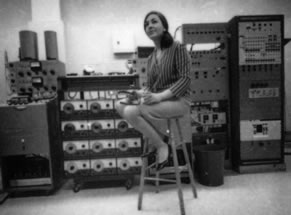
I left Canada for Europe to pursue my studies in composition in 1959. It was an eye opener for this Canadian to go to Europe and be in the midst of a musical revolution, so to speak. One of the most profound experiences for me in those years was hearing Stockhausen’s Kontakte, a piece for amplified piano and percussion instruments and four-channel tape. It was performed in Darmstadt in 1961, I believe, and simply took my breath away, and helped solidify my direction in composition.
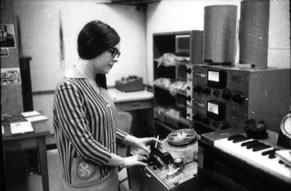
I returned to Canada in 1962, and entered the class of Myron Schaeffer at the University of Toronto in Electronic Music. I think I was accepted because of my connection with the CBC (they had donated some equipment to the University I believe). Like many Canadians, I had to go to Europe to be accepted seriously in Canada as a composer. Walter Susskind, then conductor of the Toronto Symphony asked me to write a piece for the orchestra with tape. I think he thought it a simple matter: put a tape recorder on the stage and push a button. When I presented him with a plan of loudspeakers to be placed around the hall, he backed off very quickly. I pursued my piece, in a much larger concept, and then requested a leave of absence from the CBC to go to Columbia University’s new Electronic Music Studio to realize my piece. It was a gigantic undertaking, a work for orchestra, choir, narrator and solo soprano, and three-channel tape.

As you will hear, the electronic portions of this work use very simplistic material, pre-recorded voice sounds which have been subjected to various filtering, reverb and ring-modulated processes, sine tones, white noise and sounds produced in a reverb chamber. What I would like to underline is that all the sounds are laboriously pre-recorded, cut and spliced together. This is the way we worked in those days, the only way at the time.
The composers’ materials are sounds in time and space, and whether working with instruments or magnetic tape, he or she has to think of each sound in its individual position in time, to think of pitch and pitch relationships, the duration, the timbre or quality of the sound, the attack and decay of the sound, and so on. Working with recording, cutting and splicing in those early days was an incredible lesson in learning about the parameters of sound. Highly recommended for all composition students.
Coming back to Toronto in the 60s, 1967 was Centennial Year, and just about everyone who could write a note of music was very busy. I continued to work independently in the University of Toronto Studio, and now I wish to show you some photos of the equipment available to us at that time. And I thank Gustav Ciamaga for identifying the individual pieces, as my memory is fairly vague on the technical end of things.
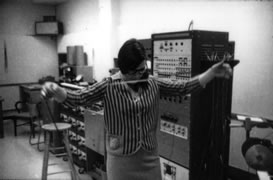
Of particular interest to me was the multitrack machine. As I remember it, there were six or eight tape heads, across which you could string tape loops. These loops, which I had prerecorded and spliced together, were of varying lengths, and were draped across the room, held by hooks in the wall or weighted down with little metal S-hooks. The varying lengths allowed me to produce and interesting sound montage, not just the same sound over and over again. But it was hazardous — the tapes would get tangled up, or the hooks would fall down or off, and then you had to start all over again. And then, of course, when everything seemed to be working well, you had to dash across the room and start the tape recorder to record your masterpiece.
I’ll play an excerpt from the piece I was working on when those photographs were taken. I used the multitrack machine a great deal in this work. The title is Elegy and Two Went to Sleep, poems by Leonard Cohen, and was written for flutist Robert Aitken, soprano Mary Morrison, and percussion initially, but Marion Ross (Bob Aitken’s wife) is heard in this recording. The page you will see shows another problem the composer had to deal with when writing for instruments and tape, and that was to develop a system of notation the performers could follow.

I should mention that I consider the use of tape as an extension of existing instrumental or vocal sounds.
Finally, I would like to thank Ron Lynch for putting together the audio-visual part of this presentation, and for the many hours he has spent helping me, and indeed teaching me, about technology, with a number of my compositions in the 70s and 80s. He has long been a great friend and collaborator.
And thank you all for listening.
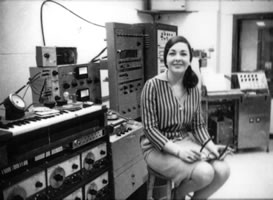

Social top